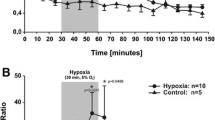Summary
In isolated gastrocnemius muscles from 19 dogs the interstitial H+ activity ([H+]int) was measured with bulb-type buffer-filled glass minielectrodes. The muscles were working isotonically and perfused with blood. In addition arterial and venous pH, venous O2 saturation, muscle temperature, and blood flow were measured continuously at rest, during 12 min of sustained exercise, and in the recovery period. Lactate (LA−) release and O2 consumption were calculated by the Fick principle. The experiments were performed under normal acid-base conditions and during artificially induced metabolic acidosis and alkalosis.
-
1.
In normal acid-base balance [H+]int at rest was 54±3.3 neq/l (=pH 7.27), while venous H+ ([H+]ven) was 45±4.7 neq/l (=pH 7.34) A[H+] gradient was always observed between interstitial fluid and venous blood.
-
2.
Immediately after onset of exercise [H+]int decreased transiently. After about 15 s [H+]int increased rapidly up to values of 105±7 neq/l (=pH 6.98). In the recovery period [H+]int diminished and reached control values after about 20–30 min. [H+]ven increased up to 74.4±8.1 neq/l (=pH 7.13). Maximal gradients between [H+]int and [H+]ven were 36 neq/l (=pH 0.2).
-
3.
During repeated exercise the decrease in [H+]int at the onset of exercise was more extensive, while the subsequent increase was lowered. These changes correspond to a smaller LA− release.
-
4.
During metabolic alkalosis at the onset of exercise [H+]int decreased less, during metabolic acidosis more than under normal acid-base conditions. Thereafter during metabolic alkalosis maximal values of 95.4±12 neq/l (=pH 7.03), during metabolic acidosis of 180±8.6 neq/l (=pH 6.74) were reached. This led to [H+] gradients between interstitial fluid and venous blood which were much higher in metabolic acidosis than in normal acid-base balance or in metabolic alkalosis. In metabolic acidosis [H+]int decreased very slowly during recovery.
-
5.
During metabolic acidosis the muscle fatigues more rapidly than during metabolic alkalosis or during normal acid-base conditions.
It is concluded that the H+ activity measured is that within the interstitial space. Exercise hyperemia is not caused by changes of [H+]int. Mechanisms are discussed which may explain H+ gradients between interstitial fluid and venous blood and rapid changes of [H+]int at the onset of exercise.
Similar content being viewed by others
References
Adler, S., Roy, A., Relman, A. S.: Intracellular acid-base regulation. J. clin. Invest.44, 8–30 (1965)
Gebert, G.: Die Messung von Na+-, K+- und H+-Aktivitäten im Gewebe mit Glasmikroelektroden. Ärztl. Forsch.26, 379–385 (1972)
Gebert, G., Friedman, S. M.: An implantable glass electrode used for pH measurement in working skeletal muscle. J. appl. Physiol.34, 122–124 (1973)
Hermansen, L., Osnes, J.-B.: Blood and muscle pH after maximal exercise in man. J. appl. Physiol.32, 304–308 (1972)
Hirche, Hj., Hombach, V., Langohr, H. D., Wacker, U., Busse, J.: Lactic acid permeation rate in working gastocnemii of dogs during metabolic alkalosis and acidosis. Pflügers Arch.356, 209–222 (1975)
Hohorst, H.-J.:l-(+)-Lactat, Bestimmung mit Lactat-Dehydrogenase and NAD. In: Methoden der enzymatischen Analyse, 2nd Ed. (Bergmeyer, ed.) Vol. II. Weinheim: Verlag Chemie 1970
Lipman, F., Meyerhof, O.: Über die Reaktionsänderung des tätigen Muskels. Biochem. Z.227, 84–109 (1930)
Mainwood, G. W., Worsley-Brown, P.: The effects of extracellular pH and buffer concentration on the efflux of lactate from frog sartorius muscle. J. Physiol. (Lond.)250, 1–22 (1975)
Manthey, J., Busse, J., Bovenkamp, U., Hirche, Hj., Hombach, V.: Lactacid and alactacid oxygen deficit in the isolated gastrocnemius of the dog. Pflügers Arch.339 R 50 (1973)
Müller-Plathe, O.: Säure-Basen-Haushalt und Blutgase. Stuttgart: Thieme 1973
Rosenthal, T. B.: The effect of temperature on the pH of blood and plasma in vitro. J. biol. Chem.173, 25 (1948)
Steinhagen, C., Hirche, Hj., Hosselmann, I., Manthey, J., Nestle, H. W., Bovenkamp, U.: Interstitial pH of the isolated working skeletal muscle during acid-base disturbances. Pflügers Arch. (Suppl.)355, R 61 (1975)
Thomas, R. C.: Intracellular pH of snail neurones measured with a new pH-sensitive glass micro-electrode. J. Physiol. (Lond.)238, 159–180 (1974)
Woodbury, W.: The cell membrane: Ionic and potential gradients and active transport. In: Physiology and biophysics (T. C. Ruch and H. D. Patton, eds.). Philadelphia-London: Saunders 1966
Author information
Authors and Affiliations
Additional information
Supported by the Bundesinsitut für Sportwissenschaft(VF 1120/8/75)
A preliminary report was given at the Spring Meeting of the German Physiological Society in 1975 [12]
Rights and permissions
About this article
Cite this article
Steinhagen, C., Hirche, H., Nestle, H.W. et al. The interstitial pH of the working gastrocnemius muscle of the dog. Pflugers Arch. 367, 151–156 (1976). https://doi.org/10.1007/BF00585151
Received:
Issue Date:
DOI: https://doi.org/10.1007/BF00585151




